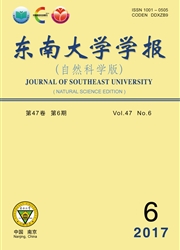

 中文摘要:
中文摘要:
从地震位移控制的原理出发,根据大跨悬索桥结构地震响应的特点,建立了其地震位移控制效果的3种评估函数,提出了一种基于罚函数和一阶优化原理的阻尼器最优布置方法.以主跨1 490m的润扬悬索桥为研究对象,基于ANSYS建立了该桥的空间有限元计算模型,采用Combin14单元对阻尼器进行模拟,用以研究大跨悬索桥地震位移控制的阻尼器空间最优布置,并给出了该桥在给定地震输入下阻尼器的最优布置.研究结果表明,对于大跨悬索桥而言,只要阻尼器数目及参数选取合理,按合理方式设置均能有效地控制结构的地震位移响应及减小大多数关键截面的地震力,但采用不同控制效果评估函数得到的阻尼器最优布置方案略有差别.
 英文摘要:
英文摘要:
After introducing the mechanism of seismic displacement control with dampers, 3 kinds of assessment functions for seismic response control effect are formulated based on the seismic response characteristics of long-span suspension bridges and a new optimal placement method of dampers using penalty function and first order optimization theory is proposed. Runyang suspension bridge (RSB), with a main span of 1 490 m, is the longest bridge in China. As an example, a spatial finite element (FE) model for RSB is established with program ANSYS, and the Combinl4 element is adopted to simulate the damper. On the basis of which seismic response analyses using different placement of dampers are carried out with the optimal placement method, and the optimal placements of dampers with the three assessment functions are then achieved, respectively. The three optimal control effects are analyzed and compared. Results show that different assessment functions can lead to different optimal placements when the number of dampers is determined, but any placement of dampers can reduce the seismic displacement significantly on condition that the parameters and the number of dampers are proper.
 同期刊论文项目
同期刊论文项目
 同项目期刊论文
同项目期刊论文
 Electrode design, measuring method and data acquisition system of carbon fiber cement paste piezores
Electrode design, measuring method and data acquisition system of carbon fiber cement paste piezores Experimental study on the contribution of the quantum tunneling effect to the improvement of the con
Experimental study on the contribution of the quantum tunneling effect to the improvement of the con Development of a wireless stress/strain measurement system integrated with pressure-sensitive nickel
Development of a wireless stress/strain measurement system integrated with pressure-sensitive nickel Experimental study on use of nickel powder-filled cement-based composite for fabrication of piezores
Experimental study on use of nickel powder-filled cement-based composite for fabrication of piezores Piezoresistive characteristic model of nickel/cement composites based on field emission effect and i
Piezoresistive characteristic model of nickel/cement composites based on field emission effect and i Fiber-reinforced polymer-packaged optical fiber sensors based on Brillouin optical time domain analy
Fiber-reinforced polymer-packaged optical fiber sensors based on Brillouin optical time domain analy A Smart Steel Strand for the Evaluation of Prestress Loss Distribution in Post-tensioned Concrete St
A Smart Steel Strand for the Evaluation of Prestress Loss Distribution in Post-tensioned Concrete St Effect of compressive strain on electrical resistivity of carbon black-filled cement-based composite
Effect of compressive strain on electrical resistivity of carbon black-filled cement-based composite Sensor technology innovation for the advancement of structural health monitoring: a strategic progra
Sensor technology innovation for the advancement of structural health monitoring: a strategic progra Environmental variability study on the measured responses of Runyang Cable-stayed Bridge using wavel
Environmental variability study on the measured responses of Runyang Cable-stayed Bridge using wavel Accurate stress analysis on rigid central buckle of long-span suspension bridges based on submodel m
Accurate stress analysis on rigid central buckle of long-span suspension bridges based on submodel m Finite element model updating for the Runyang Cable-stayed Bridge tower using ambient vibration test
Finite element model updating for the Runyang Cable-stayed Bridge tower using ambient vibration test 期刊信息
期刊信息
